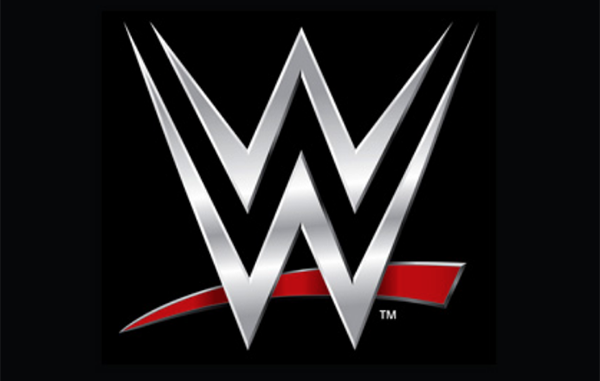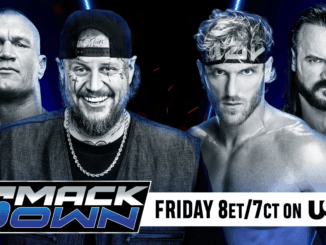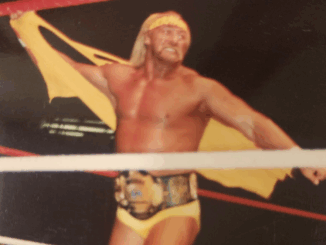
SPOTLIGHTED PODCAST ALERT (YOUR ARTICLE BEGINS A FEW INCHES DOWN)...
WWE has decided to air Raw and Smackdown live going forward, as first reported by Pro Wrestling Sheet, scraping plans to tape several weeks’ worth of content this weekend at a marathon taping. Doing a bulk taping over several days would allow wrestlers and personnel to travel less often than if wrestlers are called upon to travel every week. On the other hand, doing weekly live tapings instead of bulk tapings would allow WWE, in theory, to gather fewer wrestlers at a time at each taping, and lean on wrestlers and personnel who are self-isolating between TV events and remain driving distance from the taping sites (the Performance Center and Full Sail University campus, both in Orlando, Fla.).
ESPN published a statement by WWE regarding the matter:
We believe it is now more important than ever to provide people with a diversion from these hard times. We are producing content on a closed set with only essential personnel in attendance following appropriate guidelines while taking additional precautions to ensure the health and wellness of our performers and staff. As a brand that has been woven into the fabric of society, WWE and its Superstars bring families together and deliver a sense of hope, determination, and perseverance.
WWE also confirmed that a WWE employee tested positive for COVID-19 last month. (Something I first reported last Wednesday on the Wade Keller Pro Wrestling Podcast; I also reached out to WWE last Wednesday afternoon for comment about its policy regarding disclosing confirmation publicly or to personnel who had been around an employee who tested positive, but I did not receive a reply.) The WWE statement to ESPN reads:
A WWE employee has tested positive for COVID-19. We believe this matter is low risk to WWE talent and staff, as the individual and a roommate became symptomatic in the days following exposure to two people working in acute health care on the evening of March 26, after WWE’s TV production on a closed set was already complete. The employee had no contact with anyone from WWE since being exposed to those two individuals, is doing well, and made a complete recovery.
The WWE statement matches what PWTorch has heard from multiple sources regarding the matter. The employee, according to our sourcing, would have been in close proximity to various wrestlers as part of the course of their duties. Our sources, though, match WWE’s statement that the employee wasn’t exhibiting symptoms at the WrestleMania tapings last month, that the employee made a full recovery, and that no one around them had subsequently exhibited any symptoms. Someone can have COVID-19 and not exhibit symptoms, but still be contagious.
While WWE and AEW have continued to run original programming on their national prime time cable shows without interruption, pro sports and college sports leagues have shut down. WWE officials have said that the requirements to put on TV events are significantly different than pro sports, which have a larger number of players interacting with each other by necessity on a playing field or court, and a mixing of large groups of players and personnel in frequent games.
“We’re slightly different than other sports or entertainment where you have to travel massive groups of people to other cities, then take those massive groups of people and transport them to other cities,” Triple H told the Associated Press last month. “It’s really difficult to do, even without fans, in a safe and effective manner. For us, it was trying to continue to try and put on the product and do it as safely as possible, and we feel like we’ve been able to do that.”
WWE and AEW have been able to produce two or three hour TV shows with a relatively small numbers of wrestlers, each of whom interact in close proximity with fewer than about 5 or 6 others (and sometimes just 1 or 2 others) for a period of 10-25 minutes, which is distinctively different than a dozen players (and coaches), give or take, interacting over the course of a several-hours-long game only to then interact with a different dozen players in the next game a day or two later. Pro wrestling can more easily adjust to fewer wrestlers and a slimmed down staff since it doesn’t have to worry about the “fairness” or “integrity” of actual competition, where the playing schedule, format, setting, adjustments of normal game operations, and officiating creates concerns in competitive pro sports that pro wrestling can disregard.
NHL commissioner Gary Bettman told NBC Sports the league he oversees is looking at ways to resume games. “Nothing’s been ruled in,” he said. “Nothing’s been ruled out.”
The Minneapolis Star Tribune today published a report looking at the challenges pro team sports leagues face if they resume games, even without fans in attendance. The article states: “While logistics could be complicated, scenarios continue to emerge to reintroduce pro sports during unpredictable times.” The article details that the concern of pro sports leagues face is the sheer number of personnel required even to run empty-arena events. The article states:
How many people need to be on hand looks like an elusive target. Besides the players, coaches, and support staff like trainers, equipment managers, and clubhouse attendants, officials and umpires are also necessary. So, too, are those who help manicure the playing surface like Zamboni drivers and grounds crews. Scoreboard operators are vital; same with statisticians. But what about security for the building? And how many members of the media would be permitted? Do front-office personnel need to watch in-person? Doctors are probably essential, but are cooks?
NHL Deputy Commissioner Bill Daly wrote in an e-mail to the Star Tribune: “We are looking at all options and possibilities [and] vetting them all thoroughly so when the landscape begins to settle into some degree of predictability, we are in a position to react and plan quickly.”
Pro wrestling is different than other forms of pro sports in a key way, which pro wrestling executives have pointed out both privately to me and publicly in media statements. It takes a fraction of personnel to produce a few original pro wrestling matches each week compared to pro sports leagues with multiple games per week and roughly 30 teams per league interacting with each other, dozens of players at a time, for hours at a time. Pro wrestling’s ability to do bulk tapings is an additional mitigating factor of the risks involved.
A near “zeroing out” of the risk is difficult but possible, although it’d require a 24/7 monitoring of a quarantine of every single person who planned to attend a taping, with a two week quarantine both before and after any interactions at any tapings they attend. A fully monitored quarantine would both reduce the risk of someone showing up who has COVID-19 but isn’t yet exhibiting symptoms, and the subsequent spreading of the virus to others after the taping should someone get infected during the taping despite the precautions taken.
Switching to live weekly tapings makes two weeks of self-quarantining after tapings before returning to another taping more difficult to manage, although not impossible as long as wrestlers don’t appear on-site more than once every two (or, perhaps, every three) weeks. Wrestlers could be recorded at home or in another isolated situation for new content on the off weeks, such as live satellite interviews or workout videos or pre-recorded statements. AEW has done this. AEW has also deliberately separated its roster into two groups who are not interacting at all, with around half of their top stars based outside of the Southeast region not appearing in person at any Dynamite events for weeks. Some of the West Coast-based wrestlers have been interacting with each other on their YouTube content, including matches in a ring set up at an outdoor tennis court. AEW, with infrequent exception, has been utilizing wrestlers who are traveling to their tapings by car and not using public transpiration.
While WWE touts its social spacing practices, they have fallen short of having nothing other than essential close interaction between personnel. Just last Friday night on Smackdown, Dolph Ziggler and Sonya Deville leaned on the announce table and yelled at Michael Cole and Corey Graves, well within the six feet social distancing recommendations. That close interaction was not necessary for the execution of the TV show. Other examples of groups of wrestlers in close proximity have taken place including Rob Gronkowsky leaping onto a group of people at WrestleMania. In AEW’s first fan-free event at Daily’s Place, MJF yelled in Tony Schiavone’s face at ringside, well within the six feet recommended spacing distance. Last week on AEW Dynamite, Britt Baker needlessly circled the ring and came within a few feet of around a dozen wrestlers stationed at ringside, kissing one of them, before entering the ring for her one-on-one match.
WWE has, though, practiced stringent social distancing and germ-conscious sanitation practices. PWTorch sources say that WWE officials are policing who goes where and when to an extreme micro-managing degree. Wrestlers are isolating from each other backstage except when they go to the ring to perform, and are keeping social distance from producers and writers. The backstage scene is practically a ghost town compared to what wrestlers are used to. Personnel, off-camera, are wearing gloves and masks, bleach wipes are used on equipment in between uses, and new covers for microphones are being applied between every use with the prior one being disposed of. Anyone on-site has their temperature taken as they arrive and must sign a document saying they haven’t been in a high-risk zone or around anyone who has exhibited symptoms or tested positive.
Despite being able to point to the safety measures they are taking, WWE is still gathering people in a single location during a time when Florida Gov. Ron DeSantis issued a stay-at-home order for the state through the end of this month. Only essential businesses are supposed to be operational during that time, which includes businesses in the health care, financial, energy, food, communications, and transportation sectors. There aren’t “entertainment” exceptions. AEW abided by the stay-at-home order by moving its tapings to Georgia and conducting a mass taping the day before the Georgia stay-at-home order kicked in Apr. 3.
If the motivation for WWE running Raw, NXT, and Smackdown live is to avoid potential penalties with their lucrative TV contracts with Fox and USA Network, that would come across as putting money before the safety of wrestlers. If WWE and NXT wrestlers are traveling more often under this new weekly live scenario than they would have with less frequent mass tapings, and interacting with each other without a two-week self-quarantine between gathering again, the risk of spreading the coronavirus will be higher under the weekly live circumstances than they would have with the approach AEW took with a bulk taping at a single site, while rotating production people and wrestlers on and off the venue to minimize the number of people on-site to under 30 at any given time.
Until there are readily-available tests with near instant results, and treatments for those who get sick, there will be some risk in any format of a taping schedule no matter how few people are involved, especially with the unavoidable close physical contact of wrestlers and referees involved in a match. Two week self-quarantines before and after events, and reducing public transpiration to as close to zero as possible, is the best way to minimize and thus justify the risks involved. Until a vaccine is available and widely utilized, large crowds gathering in the thousands is unlikely to become common.
As with any workplace still operating, it’s a big responsibility for WWE and AEW officials to mitigate as much as possible a situation where one person could show up having not isolated themselves for two weeks before attending a taping. Anything short of monitored quarantines of anyone who will be in close proximity of others at TV events poses some risks, as does unnecessary social interaction within six feet on or off camera.
One WWE veteran Hall of Famer said to me last week, “The whole thing seems like it is only as strong as the dumbest motherf—er involved who isn’t taking the whole thing as seriously as everyone else.”
If pro team sports leagues begin holding games again – which seems more likely than not by summer – WWE and AEW will stand out less than they do now for having bucked the trend, although in the mean time they can point to differences between their operations and that of team sports leagues to argue in favor of their having never shut down completely. In the mean time, their right thing to do is to put safety in front of money, mitigate every risk feasible if they continue to run shows, and give wrestlers credible and concrete assurances that they have the agency to speak up about anything they’re uncomfortable with or to sit out without risk of any penalty or future punishment.
RECOMMENDED: Vince McMahon’s XFL’s future looks bleak after mass layoffs today and indications a second season very unlikely




The show “just had to go on” after Owen died and after 9/11, as well.
Sad but true.